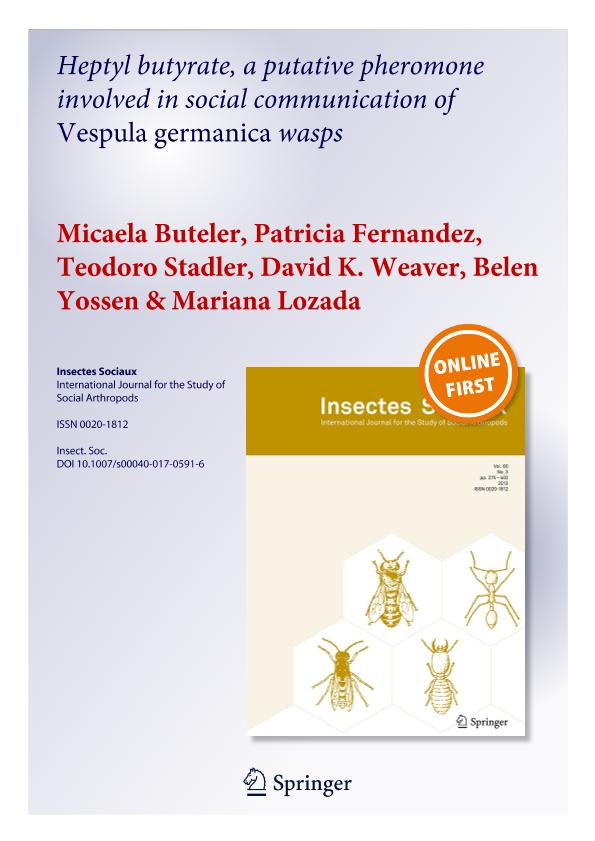Mostrar el registro sencillo del ítem
dc.contributor.author
Buteler, Micaela

dc.contributor.author
Fernandez, Patricia Carina

dc.contributor.author
Stadler, Teodoro

dc.contributor.author
Weaver, David K.

dc.contributor.author
Yossen, María Belén

dc.contributor.author
Lozada, Mariana

dc.date.available
2018-08-21T18:57:37Z
dc.date.issued
2018-02
dc.identifier.citation
Buteler, Micaela; Fernandez, Patricia Carina; Stadler, Teodoro; Weaver, David K.; Yossen, María Belén; et al.; Heptyl butyrate, a putative pheromone involved in social communication of Vespula germanica wasps; Birkhauser Verlag Ag; Insectes Sociaux; 65; 1; 2-2018; 95-101
dc.identifier.issn
0020-1812
dc.identifier.uri
http://hdl.handle.net/11336/56395
dc.description.abstract
Greater knowledge on the social communication of invasive Vespula germanica wasps is needed to fully understand their foraging behavior. This is particularly valuable considering that poison baiting is currently the only effective way of reducing wasp density. Heptyl butyrate is an attractant for many wasp species, but attempts to determine effects on V. germanica have yielded mixed results. We studied the behavior elicited by heptyl butyrate on V. germanica wasps in field experiments with foraging wasps. We also analyzed headspace volatiles of live V. germanica workers, to determine if heptyl butyrate is emitted. Heptyl butyrate was present in the headspace of live workers. Amounts of heptyl butyrate averaged 1.4 ± 0.2 ng per sample per hour, where each sample included six workers. Wasps approaching filter papers treated with different concentrations of heptyl butyrate hovered over it, but only a small percentage landed on it. Pure heptyl butyrate elicited the greatest response although all the concentrations tested were attractive. When heptyl butyrate was applied to protein baits, a greater number landed on the treated baits than on untreated ones, demonstrating this compound enhances attractiveness of baits. Results from our study suggest that heptyl butyrate is a pheromonal compound involved in attracting conspecifics to food resources, but other cues are needed to trigger landing.
dc.format
application/pdf
dc.language.iso
eng
dc.publisher
Birkhauser Verlag Ag

dc.rights
info:eu-repo/semantics/openAccess
dc.rights.uri
https://creativecommons.org/licenses/by-nc-sa/2.5/ar/
dc.subject
Attractant
dc.subject
Heptyl Butanoate
dc.subject
Recruitment
dc.subject
Semiochemical
dc.subject
Social Insects
dc.subject
Yellowjackets
dc.subject.classification
Otras Ciencias Biológicas

dc.subject.classification
Ciencias Biológicas

dc.subject.classification
CIENCIAS NATURALES Y EXACTAS

dc.title
Heptyl butyrate, a putative pheromone involved in social communication of Vespula germanica wasps
dc.type
info:eu-repo/semantics/article
dc.type
info:ar-repo/semantics/artículo
dc.type
info:eu-repo/semantics/publishedVersion
dc.date.updated
2018-06-18T19:11:25Z
dc.identifier.eissn
1420-9098
dc.journal.volume
65
dc.journal.number
1
dc.journal.pagination
95-101
dc.journal.pais
Suiza

dc.journal.ciudad
Basilea
dc.description.fil
Fil: Buteler, Micaela. Consejo Nacional de Investigaciones Científicas y Técnicas. Centro Científico Tecnológico Conicet - Patagonia Norte. Instituto de Investigaciones en Biodiversidad y Medioambiente. Universidad Nacional del Comahue. Centro Regional Universidad Bariloche. Instituto de Investigaciones en Biodiversidad y Medioambiente; Argentina
dc.description.fil
Fil: Fernandez, Patricia Carina. Consejo Nacional de Investigaciones Científicas y Técnicas; Argentina. Instituto Nacional de Tecnología Agropecuaria. Centro Regional Buenos Aires Norte. Estación Experimental Agropecuaria Delta del Paraná; Argentina
dc.description.fil
Fil: Stadler, Teodoro. Consejo Nacional de Investigaciones Científicas y Técnicas. Centro Científico Tecnológico Conicet - Mendoza. Instituto de Medicina y Biología Experimental de Cuyo; Argentina
dc.description.fil
Fil: Weaver, David K.. Montana State Univesity; Estados Unidos
dc.description.fil
Fil: Yossen, María Belén. Consejo Nacional de Investigaciones Científicas y Técnicas. Centro Científico Tecnológico Conicet - Patagonia Norte. Instituto de Investigaciones en Biodiversidad y Medioambiente. Universidad Nacional del Comahue. Centro Regional Universidad Bariloche. Instituto de Investigaciones en Biodiversidad y Medioambiente; Argentina
dc.description.fil
Fil: Lozada, Mariana. Consejo Nacional de Investigaciones Científicas y Técnicas. Centro Científico Tecnológico Conicet - Patagonia Norte. Instituto de Investigaciones en Biodiversidad y Medioambiente. Universidad Nacional del Comahue. Centro Regional Universidad Bariloche. Instituto de Investigaciones en Biodiversidad y Medioambiente; Argentina
dc.journal.title
Insectes Sociaux

dc.relation.alternativeid
info:eu-repo/semantics/altIdentifier/url/http://link.springer.com/10.1007/s00040-017-0591-6
dc.relation.alternativeid
info:eu-repo/semantics/altIdentifier/doi/http://dx.doi.org/10.1007/s00040-017-0591-6
Archivos asociados
